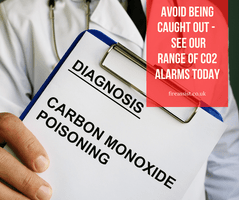Carbon monoxide poisoning, who is most at risk?
Every year there are around 60 deaths caused by carbon monoxide poisoning which can be avoided. With anybody being at risk of carbon monoxide (CO2) poisoning, it’s important to know what steps to take to prevent this happening to you. Symptoms of CO2 poisoning include chest pain, sickness, stomach pains, headaches and dizziness. Breathing in too much CO2 can even lead to unconsciousness or death.
What is carbon monoxide?
Carbon monoxide is gas that is released when fuels such as log burners and gas burners are used. For this reason, instances of CO2 poisoning increase in the winter months when it is colder and more people are indoors, heating their homes.
CO2 is a colourless, odourless, tasteless and non-irritating gas which means it is really hard to be able to tell when there is too much in your home or place of work. Carbon monoxide attaches to the haemoglobin in your blood which reduces the amount of oxygen that is carried around your body. It is for this reason why people fall ill.
Who is most at risk?
There are groups of people who are at higher risk of suffering from CO2 poisoning. This can include the elderly, infants, those on a low income or those with existing heart or breathing conditions.
For those on a low income, fuel poverty is a real problem that can lead to ill health. A 2017 study shows that those in a lower income threshold have recorded higher levels of CO2 (greater than 10ppm) in 35% of recorded homes. Fuel poverty charities such as National Energy Action support moves by the government to raise awareness of the risks of CO2 poisoning as well as acting on the links between this and fuel poverty.
Old boilers are of often the cause of CO2 poisoning as the cost of a new boiler or the upkeep of an existing one are often too costly.
The elderly are also more susceptible to CO2 poisoning as research has shown that those over 60 tend to spend more time at home and are more likely to feel the cold. For this reason, heating appliances are used more frequently meaning the chances of CO2 poisoning increase.
What causes CO2 poisoning?
CO2 is caused when there is too much carbon monoxide in your environment e.g your home. CO2 is release when fuels are burnt such as log fires, gas boilers and hobs. It is also released from car exhausts and volcanoes however, CO2 in the home is something to be much more cautious of.
What to do to prevent CO2 poisoning
The most effective way to avoid CO2 poisoning is to have a CO2 alarm fitted in your home. These will alert you when there is a high level of carbon monoxide around you that could cause harm.
From here, you should then open all windows and doors so that a flow of fresh air can enter the building. It is also really important to know where the excess CO2 is coming from which is why you should always have your appliances such as a gas boiler serviced so that everything is in working order.
There are a range of CO2 alarms on the market, all of which are suitable to alert you when there is a high level of carbon monoxide in any room. Opting for one could make the difference between life and death.
Recent Posts
-
The importance of managing false alarms - fire services and BS 5839 Part1
It’s really important to have a fire safety procedure in place should the worst happen. Having corre …22nd Mar 2021 -
FPA Launches ‘know your building’ campaign
The fire protection agency is the UK’s national fire safety organisation. It works to help identify …9th Mar 2021 -
Carbon monoxide poisoning, who is most at risk?
Every year there are around 60 deaths caused by carbon monoxide poisoning which can be avoided. With …23rd Feb 2021




